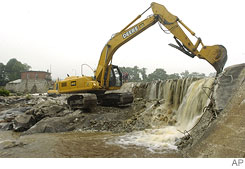 In response to environmental concerns, the Sandy River Dam is destroyed. Source of photo: online version of the WSJ article cited below.
In response to environmental concerns, the Sandy River Dam is destroyed. Source of photo: online version of the WSJ article cited below.
The WSJ summarizes an article from the March Scientific American:
Environmental concerns have led the U.S. to pull down an increasing number of aging dams in the last decade, returning water to dry streams, birds to wetlands, and migratory fish to rivers. But environmentalists are also learning a torn-down dam can leave a host of challenges, writes Jane C. Marks, an ecologist at Northern Arizona University.
Sediment that has accumulated behind the dam can muddy the waters of a river, choking insects and algae that fish need to survive. Seeds buried in the sediment might unleash alien crops that kill local species and contaminated sediment might make fish poisonous. . . .
Exotic fish can also become a problem. A dam in Arizona had been blocking exotic fish such as bass and sunfish from getting into a creek. Biologists were concerned that, without the dam, local fish in the creek would be wiped out as the exotic fish arrived.
. . .
Dams can cause dilemmas beyond the environment. Ms. Marks mentions how a father and son bitterly disagreed over the Loire dams’ removal. The father wanted the salmon and wild waters of his youth to return, whereas the son wanted to preserve the swims and boating trips of his youth.
For the full summary, see:
(Note: ellipses added.)

